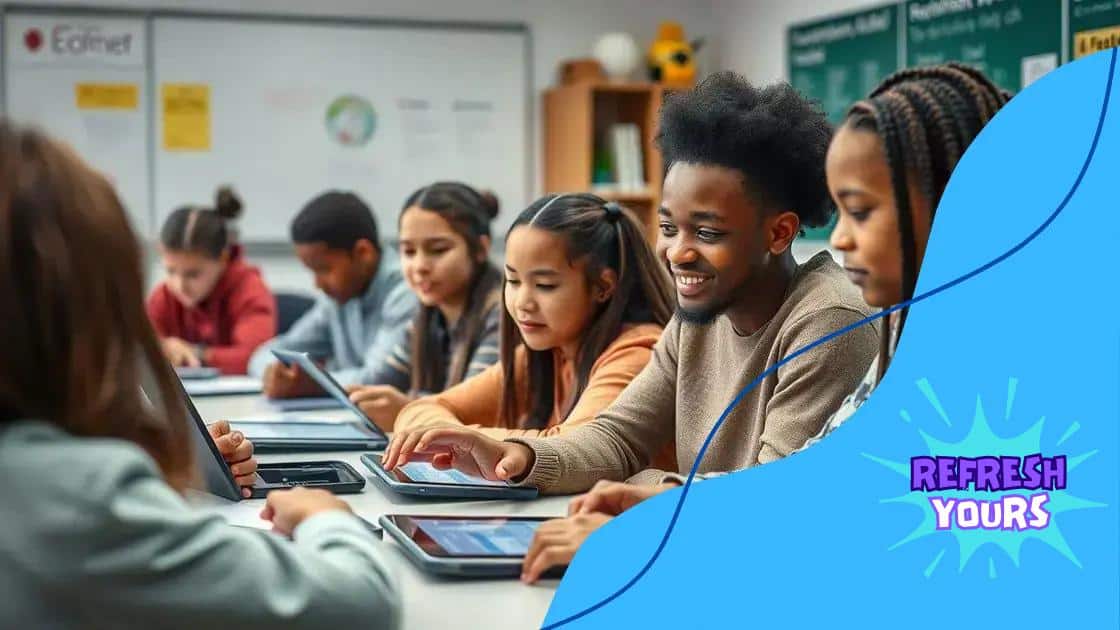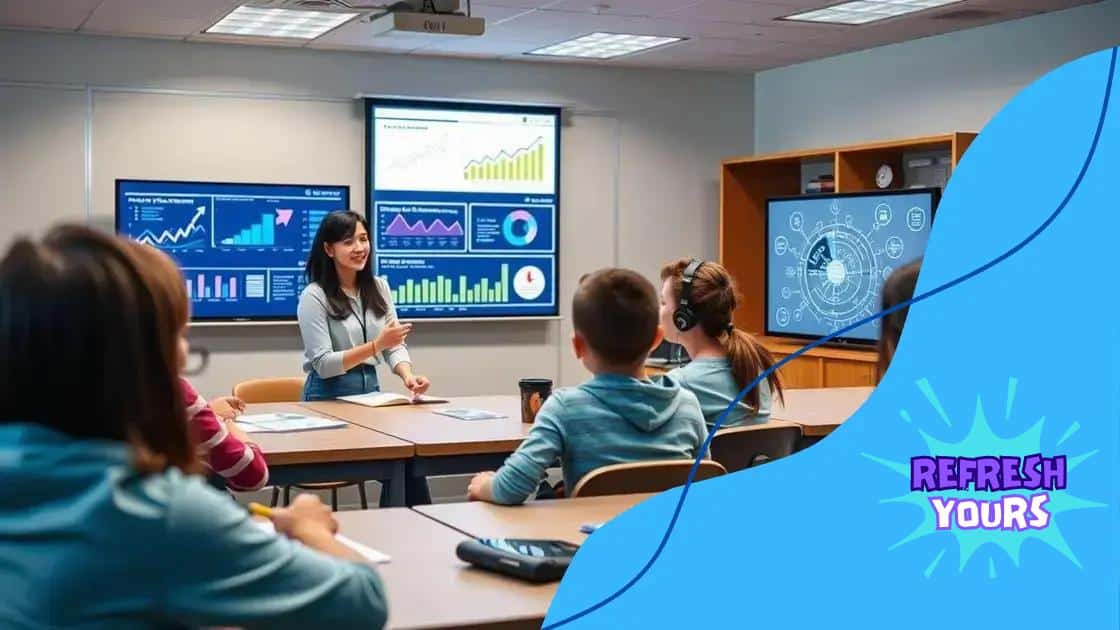The role of AI in assisting students with learning disabilities

The role of AI in assisting students with learning disabilities involves leveraging personalized tools and technologies to create tailored educational experiences that enhance engagement and academic success.
The role of AI in assisting students with learning disabilities is becoming increasingly vital in today’s educational landscape. Imagine a classroom where every learner receives personalized support tailored to their unique needs. Intrigued? Let’s dive deeper into how technology can change lives.
Understanding learning disabilities and their challenges
Learning disabilities can affect how a student processes information. Understanding learning disabilities and their challenges is the first step in helping these students succeed. These disabilities can manifest in various forms, making it crucial for educators to recognize and address them effectively.
Common Types of Learning Disabilities
There are several types of learning disabilities that can impact performance in school. Each type presents unique challenges:
- Dyslexia: Affects reading and language processing.
- Dyscalculia: Impacts mathematical understanding and skills.
- Dysgraphia: Affects writing, making it challenging to express thoughts in written form.
- Auditory Processing Disorder: Impairs the ability to process sounds and verbal instructions.
Each of these disabilities can create obstacles in a student’s education. For instance, a child with dyslexia may struggle with reading assignments, while a student with dyscalculia might find math exercises overwhelming. Recognizing these challenges is essential for creating a supportive learning environment.
Challenges Faced by Students with Learning Disabilities
Students with learning disabilities often encounter a range of challenges:
- Frustration: Struggling with traditional learning methods can lead to feelings of frustration.
- Low self-esteem: Difficulties in learning may affect their confidence.
- Social issues: They may feel isolated from peers, impacting their social interactions.
- Academic pressure: The pressure of keeping up with classmates can be overwhelming.
Addressing these challenges requires a tailored approach, often including the use of technology. By understanding the specific needs of each student, educators can implement personalized strategies to help them thrive in the classroom.
AI tools that support personalized learning
AI tools are transforming education by offering personalized learning experiences for students. These innovative technologies cater to individual needs, helping students with various learning abilities to excel. By using AI, educators can analyze student performance and adjust lesson plans effectively.
Types of AI Tools for Personalized Learning
Different AI tools are designed to enhance personalized learning in unique ways:
- Adaptive Learning Platforms: These platforms adjust content delivery based on student progress, ensuring appropriate challenges and support.
- Intelligent Tutoring Systems: These systems provide one-on-one tutoring experiences that adapt to student responses and learning speeds.
- Assessment Tools: AI-driven assessments can identify strengths and weaknesses, allowing for targeted instructional strategies.
- Gamified Learning Applications: Using game elements, these apps engage students and make learning more interactive and enjoyable.
By utilizing such tools, teachers can provide tailored educational experiences that meet the diverse needs of their students. For example, a student struggling with reading can benefit from adaptive platforms that focus on enhancing their skills through targeted practice.
Benefits of AI Tools
The incorporation of AI tools fosters several advantages:
- Enhanced Engagement: Personalized learning tools capture student interest, making lessons more appealing.
- Real-Time Feedback: Students receive immediate feedback, helping them identify areas for improvement right away.
- Individualized Learning Paths: Every student can progress at their own pace, maximizing their educational experience.
- Informed Instruction: Teachers can access valuable data about student performance to tailor their teaching methods.
The use of AI tools makes learning more accessible and effective. Students are better prepared to overcome challenges associated with learning disabilities as they receive the support they need, when they need it. This approach not only helps improve their academic performance but also boosts their confidence in their abilities.
Case studies: Successful AI applications in education

Exploring case studies on successful AI applications in education reveals how technology can reshape learning experiences for students. Various schools and institutions have adopted AI tools, leading to impressive results.
Real-World Examples of AI in Action
One notable example is the use of AI-driven tutoring systems in schools to assist students with learning disabilities. In one case, a school implemented an intelligent tutoring program tailored for students with dyslexia. This program delivered customized reading exercises, helping students progress at their own pace.
Another example involves a university that introduced an AI analytics platform. This platform analyzed student data to identify those at risk of failing. By providing targeted support, more students successfully completed their courses, illustrating the power of data-driven decision-making in education.
Positive Impacts on Student Learning
The outcomes of these AI applications have been significant:
- Increased Engagement: Students reported feeling more motivated and engaged with personalized learning opportunities.
- Improved Academic Performance: Many participating students showed enhanced grades and comprehension due to tailored instruction.
- Boosted Confidence: As students achieved success in their studies, their self-esteem improved, encouraging them to participate more in class.
- Data-Driven Insights: Educators gained valuable insights into student performance, allowing for timely interventions.
These case studies highlight how integrating AI into education can create more inclusive and supportive environments. As more schools adopt these technologies, the potential for positive change in student learning is immense.
Collaboration between AI and educators
The collaboration between AI and educators is transforming the landscape of learning. By working together, teachers and AI can create a tailored educational experience that meets the diverse needs of all students. This partnership is critical for enhancing student outcomes.
The Role of Educators
While AI provides valuable insights and tools, the role of educators remains central. Teachers use AI-generated data to understand student progress, identify areas for improvement, and develop personalized learning plans. They also bring emotional support and understanding that AI cannot provide.
For example, a teacher can use AI analytics to pinpoint a student struggling with math concepts. With this information, they can offer targeted help, either through small group instruction or specialized resources. This kind of interaction ensures that AI complements rather than replaces the teacher’s role.
Benefits of Collaboration
The collaboration offers several advantages for both teachers and students:
- Enhanced Decision-Making: Educators can make informed decisions based on AI analysis of student performance data.
- Effective Resource Allocation: Teachers can use AI to efficiently assign resources, ensuring that every student receives the support they need.
- Continuous Improvement: By receiving ongoing data and insights, educators can refine their teaching methods to better meet student needs.
- Emphasis on Individuality: AI helps highlight the unique strengths and challenges of each student, allowing for a more personalized approach.
This partnership ultimately fosters an environment where students thrive. Teachers who embrace AI technologies can better cater to different learning styles, ensuring that all students have the opportunity to succeed.
Future trends in AI for students with disabilities
As we look ahead, the future trends in AI for students with disabilities promise to bring significant advancements in education. Innovations in technology are paving the way for a more inclusive and accessible learning environment. These trends will help address the unique needs of students with various disabilities.
Emerging Technologies
Several new technologies are emerging that can enhance educational experiences:
- Speech Recognition: This technology allows students to communicate and interact using their voice, making it easier for those with writing difficulties.
- Augmented Reality (AR): AR applications can provide immersive learning experiences that help students visualize concepts in engaging ways.
- Machine Learning: By analyzing student data, machine learning algorithms can create customized learning plans, adapting to each student’s progress.
- Natural Language Processing (NLP): NLP can aid in creating more relatable educational content, making materials easier to understand for students with reading disabilities.
These technologies will help break down barriers, allowing students to engage more fully with their education. AI will adapt to each student’s learning style, providing support tailored specifically to their needs.
Increased Personalization
One major trend is the move towards increased personalization in learning experiences. AI tools will analyze how students learn best by tracking their interactions and performance. With this information, educators can develop teaching strategies that align with each student’s strengths and weaknesses.
Additionally, real-time data collection will enable swift adjustments to learning plans, ensuring that students stay on track. This flexibility will empower students, giving them a sense of ownership over their learning.
Broader Accessibility
As AI continues to evolve, accessibility will expand. More educational resources will become available online, making it easier for students with disabilities to access learning materials from anywhere. This shift will encourage a culture of independence, enhancing self-sufficiency.
Moreover, partnerships between technology companies and educational institutions are expected to increase, leading to the development of resources designed specifically for students with disabilities. By focusing on equity in education, we can create learning environments that support everyone.
FAQ – Frequently Asked Questions about AI in Education for Students with Disabilities
How does AI enhance learning for students with disabilities?
AI provides personalized learning experiences by adapting resources and strategies to fit the unique needs of each student, facilitating better engagement and understanding.
What are some examples of AI tools used in education?
Examples include adaptive learning platforms, intelligent tutoring systems, and AI-driven assessment tools that help tailor education to individual learning styles.
How can educators collaborate with AI effectively?
Educators can use AI-generated data to inform their teaching methods, develop personalized learning plans, and provide tailored support for students, enhancing overall learning outcomes.
What future trends can be expected in AI for education?
Future trends include increased personalization, wider accessibility to learning resources, and the integration of emerging technologies, which will collectively foster a more inclusive educational environment.





